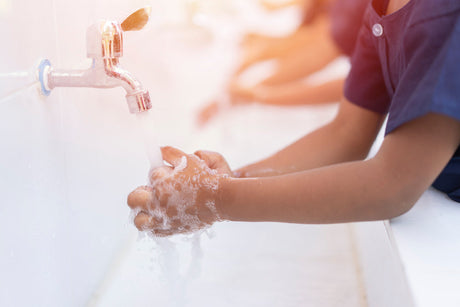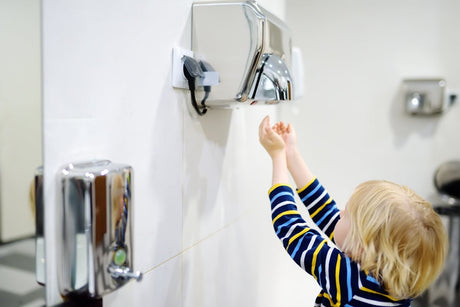How many of us think about the hygiene aspects of pubs, restaurants and hotels, but do not consider our own home as a source of infection. A 2007 Survey by The Hygiene Council found that many people do not wash their hands at home after using the toilet, stroking their pets, before preparing food, or after coughing or sneezing. Virologist John Oxford, chairman of the Hygiene Council, and Professor of Virology at Barts and The London, says people don’t think of the home as a source of infection. “They see the home as ‘safe’, but in fact it’s a place where you can get infected,” he says. “Most people have no idea how critical the simple act of washing their hands is in preventing the spread of infection.”
When thinking of trying to keep our home free of infection, however, it doesn’t mean we have to be over zealous by trying to sterilise everything. Infact Sally Bloomfield (a consultant in hygiene and infectious diseases) suggests that this ‘over- cleaning’ could actually be the reason for a rise in allergies in recent years. On the other hand, although some research supports the idea that exposure to germs can help to build a balanced immune system in children, there is no evidence to suggest that this means children need to be exposed to harmful germs or to suffer infections to build up immunity . Bloomfield suggests that the media may have popularised the idea that ‘dirt’ is good and hygiene is somehow ‘unnatural’ and that this may have contributed to lack of importance placed on hygiene in the home as a counteraction to the risk of infectious diseases.
As well as frequent hand washing, The Hygiene Council promotes the importance of regularly cleaning and disinfecting food preparation areas, as bacteria can easily be transferred from different surfaces. This should be done whenever someone in the home is ill with colds and sneezes, if a surface is in contact with any bodily fluid or has been regularly touched, and before and after preparing food. Some of the most important areas and objects to regularly clean are :- chopping boards and utensils, toilets seats and flush handles, taps, cleaning cloths , kitchen work tops, door and fridge handles, light switches, telephone hand pieces, computer keyboards, handbags, sinks, baths and showers, and rubbish bin lids.
One area that many people might not consider, is the storage of water. Although water may be clean, The Hygiene Council point out that it is no good if stored in a container that has not been cleaned or disinfected regularly, and that water should be regularly replaced and not topped up. In addition water containers should be sealed with a screw cap,
Most of us, hopefully remember to wash our hands before and after eating ( although statistics suggest that 1 in 5 people do not wash hands thoroughly enough ), but the US Centre for Disease Control and Prevention have estimated that between 50% and 80% of food borne illnesses happen in the home because food is not handled, cooked or stored properly.
We probably all think we know how to handle and cook food correctly but it’s worth reminding ourselves that food needs to be cooked long enough and at a high enough temperature to kill harmful germs. In addition, if food is not stored or prepared correctly this can lead to a risk of contamination and disease. We might all understand the need for cooked foods to be stored in a fridge, but how many of us are careful enough to store raw meat and seafood away from other foods, and to regularly clean and disinfect work surfaces and chopping boards, using separate knives and boards for cutting meat and vegetables. According to Patrick Boshell, Marketing Director at Deb Canada Hand Hygiene Inc., ‘The average kitchen chopping board has around 200 percent more fecal bacteria on it than a toilet seat. For this reason, many food safety experts advise that people use different cutting boards for red meat, chicken, fish and vegetables.’
When thinking about areas in the home that warrant the most cleaning, we probably all initially think about toilets and bathrooms, closely followed by kitchen appliances and food preparation areas, but how many of us would actually associate germs with laundry. According to the Hygiene Council studies have shown that ‘ The transfer of microbes between contaminated and uncontaminated clothing can occur during washing, and is only partially removed during the rinse cycle ‘. To reduce the spread of bacteria, recommendations include:- washing items at the highest possible temperature, drying clothes straight away( to prevent germs building up on damp items), running washing machines at a high temperature occasionally ( to prevent them becoming a reservoir for germs), and washing hands regularly after touching laundry.
In conclusion, then, what can we take away from all this information about hygiene in the home , and how worried should we be about the possibility of germs in such places as our carpets, toilets, beds as well as the spread of bacteria in different areas of the home, and on regularly handled everyday objects. To reiterate Bloomfield, there is no need to be over zealous in cleaning and sterilising or to over exaggerate the possible spread of infections and bacteria. It is however, worth noting and reflecting on what might constitute thorough and careful home hygiene and how we can encompass good practice in areas not always readily obvious.





